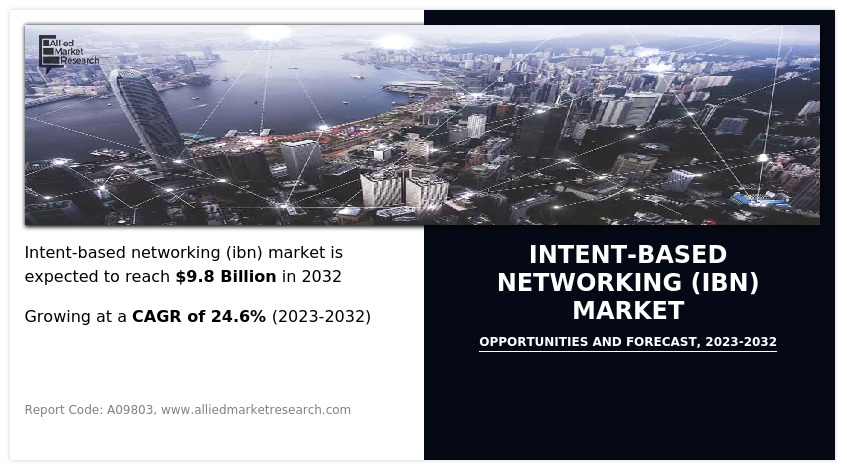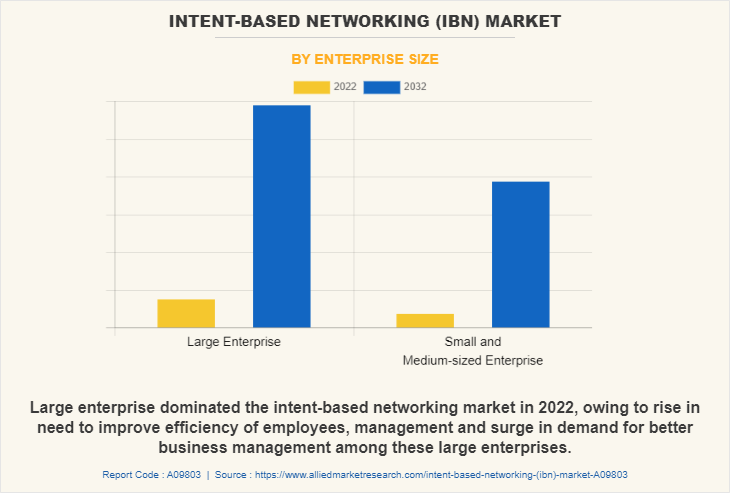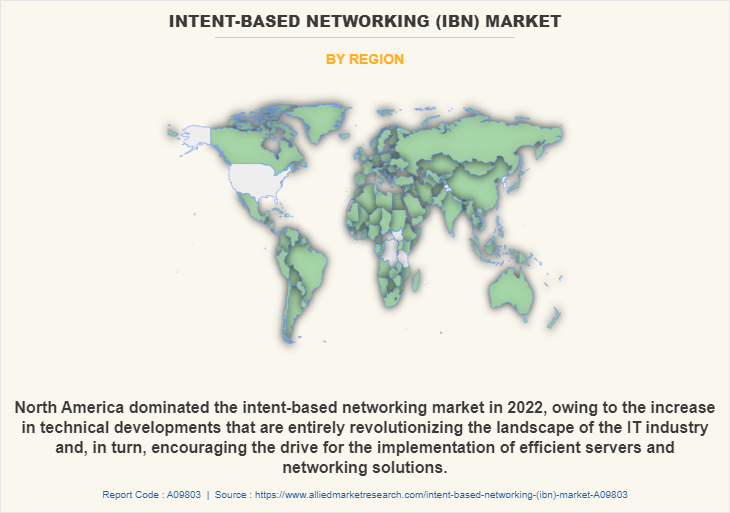Intent-Based Networking Market Research, 2032
The Global Intent-Based Networking (IBN) Market was valued at $1.1 billion in 2022, and is projected to reach $9.8 billion by 2032, growing at a CAGR of 24.6% from 2023 to 2032.
Intent-based networking (IBN) is a systematic approach to binding infrastructure management and business intent. It is a network management approach in which artificial intelligence (AI) and machine learning (ML) play a major role by automating all the organizational tasks which can be applied across the network, that helps in accomplishing a specific purpose or intent. In the IBN approach, the network can translate the intents into network policies. Further with the aid of automation, it can deploy suitable configurations to the network.
In addition, IBN constantly monitors threats, even in encrypted traffic. Security violations can be immediately acknowledged and restricted. Moreover, with the help of artificial intelligence (AI), it can provide a more secure environment for the applications in real-time. Such factors provide numerous opportunities for market growth during the forecast period.
Furthermore, IBN systems also provide a firewall to the web application which can help in internet traffic and enhance security measures. Hence, many organizations such as healthcare, IT, retail, and other sectors are investing in IBN solution due to its benefits, which is anticipated to create lucrative growth opportunities for the market in the forthcoming era.

Factors such as growing digitalization and increasing adoption of advanced technology such as IoT, cloud-based services across the world are positively impacting the growth of the intent-based networking (IBN) market trends. In addition, the increase in adoption of intent-based networking (IBN) solution across businesses to enhance operation & productivity, is anticipated to propel the growth of the market in future. Furthermore, increasing investments in various sectors such as BFSI, healthcare and other sectors are expected to provide lucrative growth opportunities for the market during the forecast period.
Moreover, IBN solution helps to reduce costs and provide high security to the application with the help of AI and ML algorithms, such benefits are predicted to create numerous opportunities for intent-based networking (IBN) market forecast. However, the IBN system has a complex design as it is a combination of several operating systems, environments, and network components, and high initial cost, are expected to hamper the growth of the intent-based networking (IBN) industry.
Key Takeaways
- The global market study covers 20 countries. The research includes a segment analysis of each country in terms of value for the projected period.
- More than 1,500 product literatures, industry releases, annual reports, and other such documents of major Intent-Based Networking (IBN) Market industry participants along with authentic industry journals, trade associations' releases, and government websites have been reviewed for generating high-value industry insights.
- The study integrated high-quality data, professional opinions and analysis, and critical independent perspectives. The research approach is intended to provide a balanced view of global markets and to assist stakeholders in making educated decisions to achieve their most ambitious intent-based networking (IBN) market growth objectives.
Key Market Dynamics
The Intent-Based Networking (IBN) Market is gaining traction as businesses and data centers demand greater network automation and efficiency. Organizations and data centers are increasingly opting for network automation and efficiency which is driving the growth of the Intent-Based Networking (IBN) …Which is enabling them to identify, troubleshoot, and fine-tune that network in a real time using Artificial Intelligence and Machine Learning technologies that helps to manage that network. The requirement of self-organizing and self-adjusting networks is very important for telecommunications, cloud service, and enterprise information technology business sectors. But there are some limitations such as integration with legacy systems and skilled personnel deficiency for IBN deployment.
Segment Overview
The Intent-Based Networking (IBN) Market market is segmented into component, deployment mode, enterprise size, industry vertical, and region. By component, it is bifurcated into solution and service. By deployment mode, it is divided into on-premise and cloud. By enterprise size, the market is segregated into small & medium-sized enterprises and large enterprises. By industry vertical, the market is classified into BFSI, IT and telecom, healthcare, retail & consumer goods, government & defense, manufacturing, and others. Region wise, the market is analyzed across North America, Europe, Asia-Pacific, and LAMEA.

On the basis of enterprise size, the large enterprise segment dominated the intent-based networking (IBN) market share in 2022 and is expected to continue this trend during the forecast period. The surge in adoption of intent-based networking (IBN) in large businesses opens numerous opportunities for the market growth. However, the SMEs segment is expected to experience fastest growth in the coming years. Factors such as surge in digitalization and increase government initiatives through various digital SME campaigns throughout the world fuel the intent-based networking (IBN) market growth.

By region, North America dominated the market share in 2022 for the intent-based networking (IBN) market. The increasing investment in advanced technologies such as cloud-based services and intent-based networking (IBN) solution to improve businesses and the customer experience are anticipated to propel the growth of the intent-based networking (IBN) market. However, Asia-Pacific is expected to exhibit highest growth during the forecast period. This is attributed to increase in penetration of digitalization and higher adoption of advanced technology are expected to provide lucrative growth opportunities for the market in this region.
Regional/Country Market Outlook
- North America: The U.S. is the largest market owing to the dominance in advanced data center infrastructure and cloud computing. Major telecom operators are adopting IBN solutions to manage their vast networks.
- Europe: IBN is gaining momentum in the healthcare and financial services sectors, which require real-time monitoring and enhanced network security.
- Asia-Pacific: Countries like China, Japan, and India are investing heavily in IBN as part of their digital transformation and 5G initiatives.
- Middle East & Africa: The Intent-Based Networking (IBN) Market is growing as telecom operators modernize their networks to keep up with the rise in data consumption.
Moreover, the key players in the market adapted various strategies such as product launch and product development to enhance their services and strengthen their position in intent-based networking market. For instance, in June 2021, Cisco Systems inc., launched a portfolio of routers to extend the power of the enterprise by expanding intent-based networking to the edge with the flexibility, security and scalability needed for IoT success. The portfolio enables organizations to run connected operations at scale with choice of management tools suited for both IT and operations. As a result, the enhancements in intent-based networking boosted the market demand during the forecast period.
Competitive Landscape
The major players operating in the Intent-Based Networking (IBN) Market providers in the industry include Cisco Systems, Inc., Juniper Networks, Inc., Huawei Technologies Co., Ltd., Hewlett Packard Enterprise Development LP, NetBrain Technologies, IBM Corporation, Gluware, Wipro, Forward Networks, Inc. and Nokia Corporation.
Report Coverage & Deliverables
This report delivers in-depth insights into the intent-based networking (IBN) market overview, covering component, deployment mode, enterprise size, industry vertical, and region, and key strategies employed by major players. It offers detailed market forecasts and emerging trends.
Component Insights
Solutions focus on various functionalities such as automated configuration management, performance analytics, and proactive security measures, allowing organizations to align their network performance with business intent seamlessly.
Deployment model Insights
Many organizations prefer on-premise deployment for IBN solutions to maintain control over their network environments and data security. This model is particularly prevalent in industries with stringent regulatory requirements, where businesses need to ensure compliance and mitigate data privacy concerns.
Enterprise Size Insights
SMEs are increasingly adopting IBN solutions to enhance their network efficiency and security without the need for large IT teams. These enterprises benefit from simplified management and cost-effective deployment options that enable them to compete with larger organizations.
Industry Vertical Insights
The BFSI sector is a major driver of IBN adoption due to the high demand for secure, reliable, and efficient networks to handle sensitive financial data. Companies in IT and Telecom sector leverage IBN for automating network management and enhancing service delivery, ensuring high availability and performance.
Regional Insights
North America dominates the intent-based networking (IBN) market, driven by advanced technological infrastructure, high adoption rates of cloud technologies, and significant investments in network security. Asia-Pacific is the fastest-growing region, fueled by rapid digitalization, rising internet penetration, and the expanding adoption of IoT technologies across various sectors, including manufacturing and telecom.
Key Strategies/Development:
In March 2023: Cisco Systems Inc. launched cloud services in IoT operations dashboard to increase industrial asset visibility, securely manage assets from anywhere and provide intent-based networking and industrial internet of things (IoT) customers with a seamless path to automation for operational technology (OT) teams.
- In March 2023: Hewlett Packard Enterprise expanded its intent-based networking security capabilities by offering solution to meet the increasing demand for integrated networking and security solutions delivered as-a-service as it entered into a definitive agreement to acquire Axis Security, a cloud security provider.
- In February 2023: Huawei Technologies Co., Ltd. launched the digital managed network solution to boost intent-based networking and growth for carriers' B2B services. This solution provides digital managed network capabilities and rich product portfolios, helping carriers transform from ISPs to MSPs.
- In February 2022: Wipro enhanced and expanded its intent-based networking position as a network transformation solution provider through in-house development, partnering with original equipment manufacturers (OEMs), strategic investments and acquisitions to evolve smart city assurance drone service and edge-based analytics.
- In October 2021: IBM and Cisco Systems inc., expanded their relationship, and integrate key offerings, including IBM cloud Pak for network automation and Cisco Crosswork network automation software, to enhance intent-based networking.
Top Impacting Factors
Rise in demand for software-enabled automation process:
The demand for intent-based networking is being driven by factors including the developing applications of automation. Intent-based networking uses a software-enabled automation process that involves high levels of intelligence, analytics, and orchestration to improve network operations and uptime. The network transforms the business results that operators specify into the configuration required to achieve those goals, eliminating the need for each action to be manually coded and carried out. As a result, key players in the Intent-Based Networking (IBN) Market enhanced their services to strengthen their position in the intent-based networking market. For instance, in July 2021, Gluware enhanced its intent-based networking services for enterprise networks with its intent-based and model-driven automation and management technology.
Furthermore, intent-based networking system automatically generates a full configuration of all devices based on the service description. It provides ongoing assurance checks between the intended and operational state of the network, using closed-loop validation to continuously verify the correctness of the configuration. For instance, in January 2021, Juniper Networks acquired Apstra that provides intent-based networking and automated closed-loop assurance. Apstra brings network automation based on an open, multivendor architecture to Juniper’s data center networking portfolio. Such development fostered the growth of the intent-based networking market.
Increase in adoption of cloud-based services:
Rise in demand for intent-based networking is attributed to cloud-based services as it offers connectivity to and between applications and workloads across clouds, cloud services, on-premises data centers, and edge networks. In addition, multi-cloud and hybrid systems offer essential services to intent-based networking, including security and effective management. The key advantages of a well-implemented cloud-based services for intent-based networking strategy include ease of lifecycle management, guarantee of the user experience, lower operational expenses, and reduced risk for applications and data. As a result, key players in the market adapted cloud intent-based networking services to provide enhanced services and strengthen their positions in the market. For instance, in July 2022, Juniper Networks launched cloud metro a new category of solutions for service providers. It focuses on enabling sustainable business growth, with a series of high-performance networking systems, powered by AI-enabled, cloud-delivered automation, specifically designed to build next generation cloud metro infrastructure. These cloud-based enhancements are expected to fuel the growth of the market in the upcoming years.
Key Benefits For Stakeholders
The study provides an in-depth intent-based networking (IBN) market analysis along with the current trends and future estimations to elucidate the imminent investment pockets.
- Information about key drivers, restraints, and opportunities and their impact analysis on the intent-based networking (IBN) market size is provided in the report.
- The Porter’s five forces analysis illustrates the potency of buyers and suppliers operating in the intent-based networking (IBN) industry.
- The quantitative analysis of the global Intent-Based Networking (IBN) Market for the period 2022–2032 is provided to determine the intent-based networking market potential.
Intent-Based Networking (IBN) Market Report Highlights
| Aspects | Details |
| Market Size By 2032 | USD 9.8 billion |
| Growth Rate | CAGR of 24.6% |
| Forecast period | 2022 - 2032 |
| Report Pages | 405 |
| By Component |
|
| By Deployment model |
|
| By Enterprise Size |
|
| By Industry Vertical |
|
| By Region |
|
| Key Market Players | wipro, Hewlett Packard Enterprise Development LP, Gluware, Huawei Technologies Co., Ltd., Cisco Systems Inc., Forward Networks, Inc., IBM Corporation, Juniper Networks, Inc., NetBrain Technologies, Nokia |
Analyst Review
Over time, businesses have seen various changes in the business processes, operations, and industrial automation. As more businesses become reliant on internet connectivity for business-critical and cloud applications, IBN is becoming a necessity. It is designed to improve uptime and business agility while reducing operational costs and complexity. Intent-based networking has become a reality and offers its benefits to various industries with the advancement of machine learning, artificial intelligence, and networks. Intent-based networking has grown to be a popular term in time and has its set of benefits for businesses. Considering the pandemic, recent remote working, and work-from-home scenarios, businesses have shifted their focus on their networks and networking solutions. This, in turn, is expected to propel the growth of the market.
Furthermore, IBN uses an innovative approach to redesign and deploy networks that focus on all aspects of a company’s IT infrastructure rather than only hardware assets. IBN addresses challenges related to managing enterprise networks, using AI and machine learning to execute regular activities, define rules, respond to system events, and verify that objectives and actions are required. Such advantages are expected to provide numerous opportunities for IBN market growth during the forecast period.
Moreover, intent based networking has emerged as the latest trend in IT. Modern vendors are exploring the benefits of Intent based networking. Intent based networking offers revolutionary ways to transform IT infrastructures and cloud adoptions. with the support of machine learning and analytics. In addition, IBN offers efficiency by helping users to apply policies across entire network infrastructure. This technology has gained momentum in the past few years. Such factors are expected to create lucrative opportunities for the intent-based networking (IBN) market during the forecast period.
Nevertheless, prominent market players are exploring new technologies and applications to meet the increase in customer demands. Product launches, collaborations, and acquisitions are expected to enable them to expand their product portfolios and penetrate different regions. Emerging economies provide lucrative opportunities to market players for growth or expansion. For instance, in March 2023, Cisco Systems inc. launched cloud services in IoT operations dashboard to increase industrial asset visibility, securely manage assets from anywhere and provided intent-based networking and industrial internet of things (IoT) customers with a seamless path to automation for operational technology (OT) teams. Meanwhile, in March 2023, Hewlett Packard Enterprise expanded its intent-based networking security capabilities by offering solution to meet the increasing demand for integrated networking and security solutions delivered as-a-service as it entered into a definitive agreement to acquire a cloud security provider, Axis Security. Such enhancements are expected to offer numerous opportunities for the market in the coming years.
The Intent-Based Networking (IBN) Market is Expected to Reach $9,753.61 Million by 2032.
The North America is the largest market for the Intent-Based Networking (IBN).
Factors such as growing digitalization and increasing adoption of advanced technology such as IoT, cloud-based services across the world are positively impacting the growth of the IBN market.
The key growth strategies for Intent-Based Networking (IBN) include product portfolio expansion, acquisition, partnership, merger, collaboration and others.
Cisco Systems, Inc., Juniper Networks, Inc., Huawei Technologies Co., Ltd., Hewlett Packard Enterprise Development LP, NetBrain Technologies, IBM Corporation, Gluware, Wipro, Forward Networks, Inc. and Nokia Corporation are some of the top companies.
Loading Table Of Content...
Loading Research Methodology...



